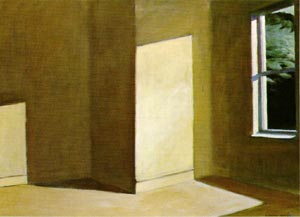A look back at Hopper
A short tribute to American artist Edward Hopper appeared in this space a couple months ago, following the opening of the retrospective exhibit of his work at Boston's Museum of Fine Arts. The retrospective is now on the road, showing currently at the National Gallery of Art in Washington, then moving to Chicago's Art Institute in January. Art and culture critic Martha Bayles of Boston College has written her own tribute to Hopper as a review of the exhibit.
The theme in her tribute is "painter of light," and that Hopper certainly is. Bayles' perceptive realization is that Hopper was a painter of light - the real thing and very difficult to capture on the canvas - and of not lighting. No one who has seen his paintings in the original can disagree. The origin of Hopper's early mastery of light is his native New England summers and autumns. This light is brilliant for a few months, but becomes unique in its mixture of shallow angle and distinctive landscape in fall and early winter.

The most common perception of Hopper's paintings is their strikingly absence of people in some cases, and their apparent alienation and lack of connectedness in others. All of them seem to be listening to something, but not to each other or to us. They also communicate a very American sense of transience and alienation. A sense of openness and possibility, but with people never seeming to quite fit in, is American as apple pie, although Americans often have a hard time recognizing it - Europeans and others usually sense it more quickly. It's a similar quality that Dvořák captured in the slow movement of his Ninth Symphony (From the New World). Amid the famous spiritual and Indian chant melodies, the movement unwinds into a musical "night on the plains," with its bright stars, distant lights and trains - and no one for miles.
If you're in Washington or Chicago during the Hopper retrospective, don't miss it.


0 Comments:
Post a Comment
<< Home